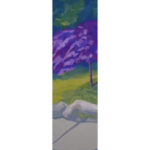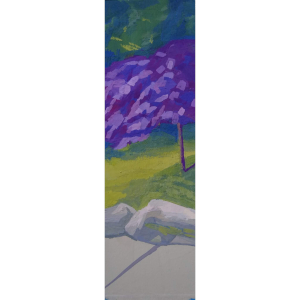Redbud and Rocks

This week, I came across a fantastic Redbud and rocks on my morning walk. There are so many paintings circulating in my mind after seeing this tree and several of it’s companions. But before I share more, here’s the purpose of this post, blog and a welcome to new readers here.
Small Spaces Special Places
Each year, I select a theme for my weekly paintings. This year’s is “Small Spaces Special Places.” Why? I have been surprised, even delighted, with the small spaces in our house that have captured my eye.
Also, there are the special places I see on my daily dog walks. Each morning, rain or shine, I love getting outdoors and looking for things to paint. Sometimes, we venture on the road and I share paintings of special places from these trips, too.
If you or someone you know will enjoy a weekly dose of color, sign up here for this weekly blog. Let’s get to this week’s topic, shall we?
Challenge and Knowledge
So this is the third week that I have been challenging myself to share knowledge about composition. During the first week, I kept the tips simple. For instance, an artist needs to know the dimensions of the drawing or painting. To support this effort, the artist can use a viewfinder. Both of these tools aid in the selection of the topic. I love using the viewfinder to start honing in on the idea for my next painting.
As I continued to share in week two, I posted photos of Master Paintings I had copied. Why? It’s super fun to copy a painting from Art History for so many reasons. It helps the painter (moi), imagine the mind, eyes, hands, even paint handling of the artist.
Most of my paintings during the second week were of a single object. Why? Because I wanted to show the impact of the rule of thirds. What is this rule? Imagine lines dividing a surface into equal blocks. Composition is pleasing when elements land on one or two of the points of intersection.
Another helpful composition tip is to do sketches aka compositional sketches. These do not have to take a lot of time. But, they can certainly save you time in the long run. Why? Well, you can plan that tree or person within the dimensions of the painting so that they ‘fit’ properly. Raise your hand if you’ve drawn something only to have it run off the page. Gah! Compositional sketches reduce this likelihood.
Definition
Before I carry on too much more, I think it might help to define composition. Don’t you? To me, the clearest definition of composition, came from this painter’s website here. Here are the elements of composition in Western art: balance, contrast, emphasis, motion, pattern, proportion, rhythm, and unity. I plan to incorporate these elements into this conversation too. But, for now, I will share this week’s composition challenge.
Why Redbud and Rocks
When I saw the Redbud tree, I immediately thought of Sakai Hoitsu’s painting at the Metropolitan Museum in New York. Isn’t it elegant and gorgeous? I find that I am drawn to paintings with narrow widths and long heights. I’m not sure why? But, I recall that my parents visited Japan when I was a child. They returned with a lovely Japanese scroll pen and ink painting. They hung it in our dining room. So I saw that painting everyday for years. Maybe that is the source of my interest?
Sketches of Redbud and Rocks
I tried several different compositional sketches of this Redbud and rocks. I also started off thinking I would paint a square image. Why? Because the shape of the tree is quite square. But as I drew and sketched, I found myself wishing for the narrow width and long height. Even after enthusiastically choosing the narrow, long surface, I still changed the composition of the painting. How? I darkened the area directly underneath the tree. Why? I wanted to make sure the viewer noticed the rocks along the sidewalk. Before I darkened that area, the rocks disappeared into the green grass.
Notan of Redbed and Rocks
This week I challenged myself to do several Notans of this painting too. It seems appropriate to use a technique with origins in Japan to study this rather Japanese composition. Don’t you think? Notan is clearly defined by Mitchell Albala in his blog. He suggests that Notan is a shape and pattern defining tool. Since we are in search of the elements of composition, what better way to do so than Notan. How? Take any image and reduce it to black and white. That’s right. This exercise is more challenging than you might think. But once you have have assigned all elements to either black or white, you clearly see shapes and patterns. This will help you assess the effectiveness of a composition.
Name that Composition
So there are names associated with different types of compositions, too. I will define them each. But for now, take a look at this week’s painting. Do you see a shape or pattern in it? What about line direction? Are there notable lines that you see?

If you said you see diagonal lines, I would agree with you. If you said you see an “S” shape, I would also agree. The “S” starts in the lime green area to the right of the tree trunk. Then it curves to the left side of the painting. The “S” continues through the rocks and back to the left and off the canvas. Did I strategically plan this composition ahead of time? Heck no! I used a very preliminary sketch (that I can’t find…sorry!!!).
Then I took my time painting, assessing and painting. I arrived at a solution that felt simplified enough to communicate the subject without being too busy. So, there you have it dear reader, a conversation in composition.
Have you got a favorite composition or painting that you would like to share? If so, please do tell in the comments below and thank you!

2 Comments
Beth Dyer Clary
May 20, 2021LOVE this painting, Julie! Saw it on Instagram early this morning and knew it was due to the gorgeous purple and the shape of the image. So dramatic and different than the usual square or “landscape” image. The shape of the painting makes the image pop to my eye. Love it.
Fascinating to learn about your process. You get a lot done in a week!
Julie Holmes
May 26, 2021Hi Beth,
Woot! Thanks so much for reading and commenting. This was a fun shape to work in. Hoping to do more of them soon!
Take care and thanks again and lots o’ love!